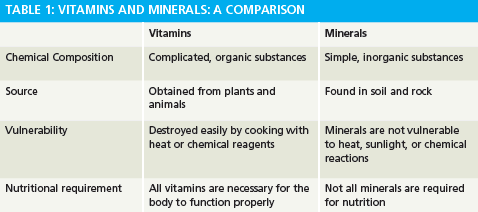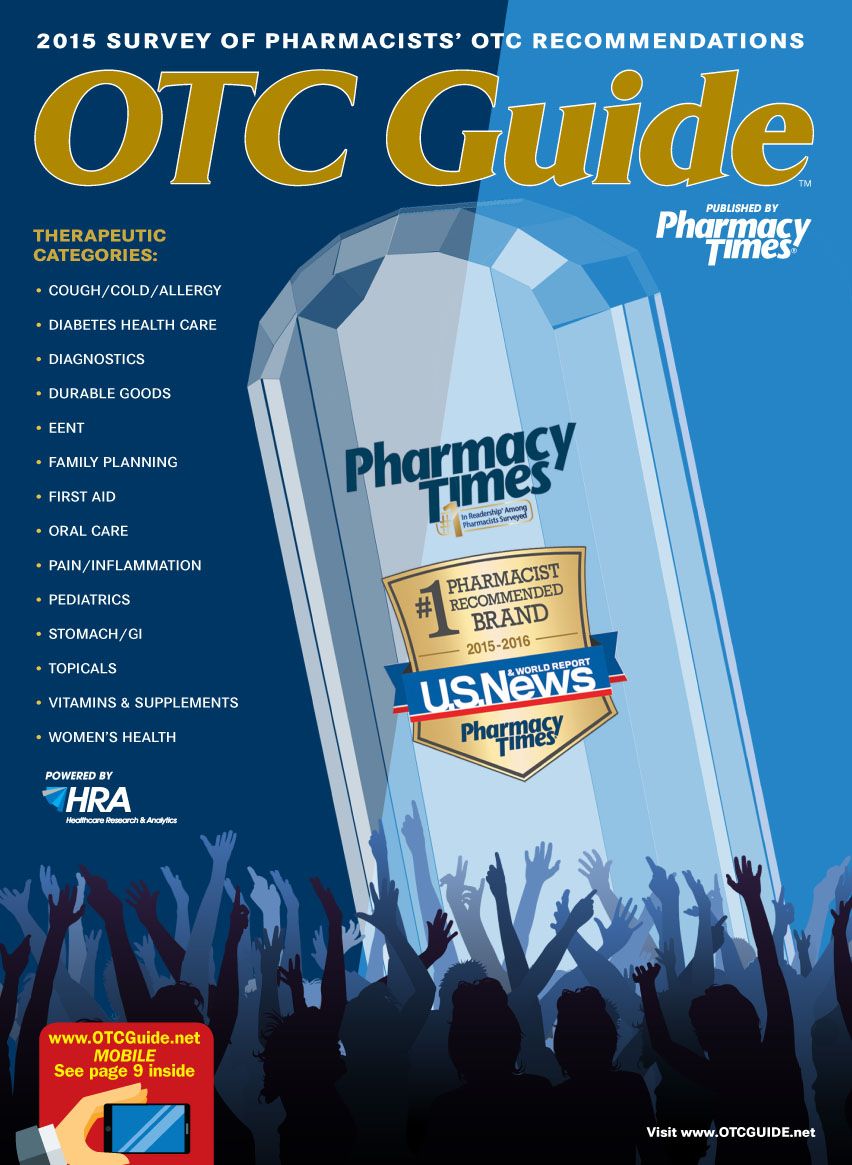Publication
Article
OTC Guide
Vitamins and Minerals Explained
Author(s):
Vitamins and minerals: why you need them and where to find them.
Vitamins and minerals: why you need them and where to find them.
There are 13 essential vitamins (A, B, C, D, E, and K, with 8 vitamins in the B complex) and many minerals the body requires for optimal health. If you eat a balanced, healthy diet, you are probably already getting adequate amounts of the essential nutrients your body needs to function at its best level. If you are following a restricted diet or have certain health conditions, however, you may need a multivitamin or other dietary supplements. Ask a doctor or pharmacist before taking any supplement, including a multivitamin, to avoid getting too much of a good thing.
Vitamins and Minerals: What’s the Difference?

Vitamins are made by living things, while minerals are found in the earth. For example, carrots produce beta carotene, which the body turns into vitamin A; minerals, such as iron and copper, can be found in soil and rock. Vitamins are much more delicate than minerals and can break down with heat or age, and they are organic; minerals are inorganic, making their chemical form more simple than that of vitamins.
Whereas all vitamins are needed by the body, only some minerals are required for nutrition. Examples of necessary minerals include calcium, chromium, copper, iodine, iron, magnesium, manganese, phosphorus, potassium, sulfur, sodium, and zinc. Minerals and trace elements are mainly found in meat, cereals, fish, milk and dairy foods, vegetables, dried fruit, and nuts. See Table 1 for a comparison of vitamins and minerals.
Calcium: An Important Mineral for All Age Groups
Calcium is necessary for strong bones and health, is needed for blood to clot, and helps nerves to send messages and muscles to contract. People of all ages are encouraged to meet their recommended dietary allowance for calcium (Online Table 2), particularly those at highest risk for low calcium intake from food: children 9 years and older, adolescent girls, adult women, and adults 51 years and older.
Table 2: Recommended Calcium Intakes
Age
mg/day
Infants 0-6 months
200
Infants 6-12 months
260
1-3 years
700
4-8 years
1000
9-18 years
1300
19-50 years
1000
51-70 years (men)
1000
51-70 years (women)
1200
>70 years
1200
14-18 years (pregnant/lactating)
1300
19-50 years (pregnant/lactating)
1000
Iron
Iron, which is necessary for transporting oxygen in the blood and important for generating energy from nutrients, is an essential mineral naturally present in some foods, such as lean meats and seafood, nuts, beans, and fortified foods. Groups at risk of an iron deficiency include pregnant women, infants and young children, teenage girls, and premenopausal women.1
If your blood iron level is low, your doctor might recommend an iron supplement. Take an iron supplement as directed to avoid overdosing, which can lead to serious adverse effects. It is especially important that iron supplements be stored out of reach of children, as an iron overdose in children can be highly toxic—even fatal.
Fat- and Water-Soluble Vitamins
Vitamins B and C are water-soluble and move around the body more easily than fat-soluble vitamins. Water-soluble vitamins are not stored in the body; you need a continuous supply of them in your diet. When taken in excess, water-soluble vitamins are removed from the body through urine.
Vitamins A, D, E, and K, the fat-soluble vitamins, bind to fat in the stomach and are then stored in fatty tissues and the liver. These vitamins are not excreted readily, and when taken in excess, they can build up in the body and lead to unwanted, and potentially dangerous, adverse effects.
Antioxidants
Antioxidants are substances that may prevent or delay some types of cell damage by counteracting free radicals— chemicals that can harm cells. Examples of antioxidants include vitamins A, C, and E; beta carotene; lycopene; and selenium. Antioxidants have been credited with a number of health benefits ranging from reducing the signs of aging to preventing certain cancers and Alzheimer’s disease. Although antioxidants naturally found in fruits, vegetables, and grains may help to prevent certain diseases, research has not shown that high doses of antioxidant supplements prevent disease.2 Clinical trial results are mixed, but most have found disappointing results.
Vitamin A
Widely known for its importance to good vision, vitamin A also supports the immune system and is necessary for a healthy pregnancy. Vitamin A deficiency is rare in the United States; it is largely a problem of developing countries.3
Vitamin A can come from both plant and animal sources. Plant sources include leafy green vegetables and orange and yellow fruits and vegetables. Animal sources include liver, salmon, and whole milk. Vitamin A is also added to fortified cereals, is a part of most multivitamins, and is available as a stand-alone supplement.
Vitamin B
The B complex family of vitamins is made up of 8 B vitamins, each of which performs a different important function throughout the body (Online Table 3).
Table 3: B Vitamins
Nutrient
Name
Functions
Sources
B1
Thiamin
Produces cellular energy from food; required for the synthesis of DNA and RNA
Cereals, whole grains, enriched refined grains, potatoes, pork, seafood, liver, and kidney beans
B2
Riboflavin
Helps the body produce energy; affects enzymes that influence the muscles, nerves, and heart
Cereals, whole grains, enriched refined grains, enriched bread, dairy products, liver, and leafy green vegetables
B3
Niacin
Energy production; helps keep the skin, nervous system, and digestive system healthy
Liver, fish, chicken, lean red meat, nuts, whole grains, dried beans, and enriched refined grains
B5
Pantothenic acid
Influences normal growth and development
Found in almost all foods
B6
Pyridoxine
Helps break down protein; helps maintain the health of red blood cells, the nervous system, and parts of the immune system
Fish, liver, pork, chicken, potatoes, wheat germ, bananas, and dried beans
B7
Biotin
Helps break down protein and carbohydrates; helps the body make hormones
Peanuts, liver, egg yolks, bananas, mushrooms, watermelon, and grapefruit
B8
Folic acid, folate
Helps the cells in the body make and maintain DNA; important for the production of red blood cells
Leafy green vegetables, liver, citrus fruits, mushrooms, nuts, peas, dried beans, and wheat bread
B12
Cobalamin
Plays a role in the body’s growth and development, and nerve function
Eggs, meat, poultry, shellfish, milk, and milk products
Vitamin B9 (folic acid) can help prevent birth defects of the brain and spine, known as neural tube defects. It is recommended that all women who are capable of becoming pregnant consume 400 mcg per day of folic acid from fortified foods or from dietary supplements.
Vitamin B12 is important for nerve function and development. A deficiency can cause symptoms such as numbness, weakness, difficulty walking, yellowed skin, and memory loss. The elderly, vegetarians, vegans, and people who have undergone weight loss surgery are at risk of developing a vitamin B12 deficiency.
Vitamin C
Vitamin C is necessary for growth and repair of tissues in all parts of the body. You may have also seen ads touting the benefits of vitamin C during cold and flu season, but these claims continue to be the source of great debate. Although research shows that vitamin C supplements do not reduce the risk of getting the common cold for most people, regular vitamin C supplement intake may help to shorten cold duration and reduce symptom severity. Using vitamin C supplements after cold symptoms begin does not appear to be helpful.4 Foods high in vitamin C include citrus fruits, strawberries, blueberries, broccoli, green peppers, spinach, and tomatoes.
Vitamin D
Research conducted over the past decade suggests that vitamin D, besides building strong bones, may play an important role in preventing and treating a number of serious long-term health problems, such as osteoporosis, heart disease, some cancers, and multiple sclerosis.
Vitamin D is both a nutrient in food and a hormone our bodies make through sun exposure. It is important for bone health because one of its main functions is helping the body absorb calcium. Few foods are naturally rich in vitamin D. The best dietary sources of vitamin D are fatty fish, such as salmon, tuna, and mackerel; fortified dairy products; and breakfast cereals.
Vitamin E
Vitamin E is used for cell communication, to strengthen the immune system, and to form red blood cells. Much like vitamin D helps the body use calcium, vitamin E helps the body use vitamin K. In the past, it was believed that taking vitamin E supplements also might prevent a variety of diseases, including heart disease, cancers, and Alzheimer’s disease. However, current research provides little evidence that taking vitamin E supplements prevents these diseases, and the risks and benefits of taking vitamin E are still unclear.
Vitamin E is found naturally in foods and is added to some fortified foods. You can get the recommended daily amount of vitamin E by eating a variety of foods, such as vegetable oils, nuts and seeds, green vegetables, and enriched cereals.
Vitamin K
Vitamin K is a group name for a number of compounds that help the body make proteins necessary for blood clotting. Because of this role, vitamin K is used to reverse the anticoagulant effects of blood thinners when too much is given. For this reason, people taking blood thinners may need to be careful about how much vitamin K they take in. Vitamin K is also given to newborns who do not have enough of it naturally occurring to prevent clotting problems. Vitamin K can be found in leafy greens, cruciferous vegetables (such as broccoli or cabbage), fish, liver, meats, and eggs.
A Balanced Diet: The Key to Nutritional Success
While dietary supplements can be beneficial, the key to nutritional success is eating a balanced diet. Because some people may need supplements to help meet their nutritional needs, a registered nutritionist can help you evaluate your dietary needs and determine whether a vitamin or mineral supplement is right for you.
Ms. Bolt is a clinical pharmacist and medical editor residing in northern California.
References
- Iron: dietary supplement fact sheet. National Institutes of Health Office of Dietary Supplements website. http://ods.od.nih.gov/factsheets/Iron-HealthProfessional/#h6. Accessed March 9, 2015.
- Antioxidants and Health: An Introduction. National Institutes of Health National Center for Complementary and Integrative Health website. https://nccih.nih.gov/health/antioxidants/introduction.htm. Updated November 2013.Accessed March 3, 2015.
- Vitamin A: fact sheet for consumers. National Institutes of Health Office of Dietary Supplements website. http://ods.od.nih.gov/factsheets/VitaminA-Consumer/. Accessed March 3, 2015.
- Douglas RM, Hemila H, Chalker E, Treacy B. Vitamin C for preventing and treating the common cold. Cochrane Database Syst Rev. 2007;(3):CD000980.







